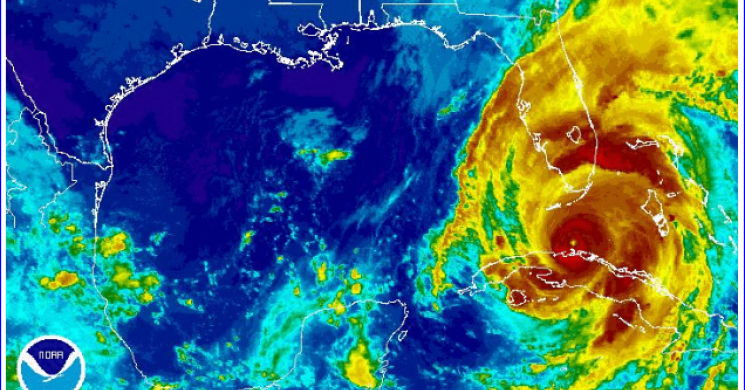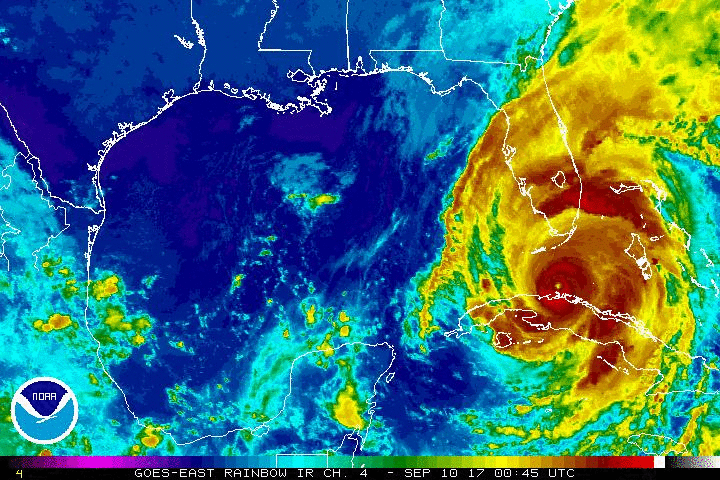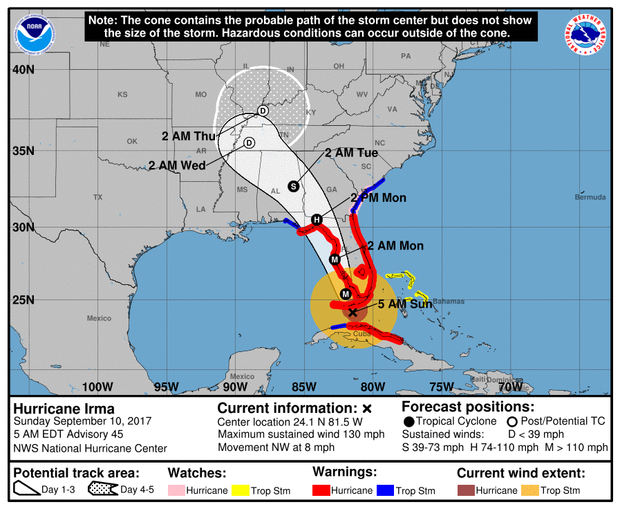
Hurricane Irma Makes Landfall As Florida Braces For Destruction: Live Feed
According to the NHC, the center of Hurricane Irma made landfall at Cudjoe Key in the lower Florida Keys at 9:10 am EDT, with maximum sustained winds of 130mph. A gust to 106 mph (171 km/h).
The National Hurricane Center forecasts that the core of Hurricane Irma will likely head directly for the highly populated Tampa-St. Petersburg region after it gets through raking the Keys, but the storm is so massive all of Florida will be feeling the Category 4 hurricane's fury.
The center of the storm was just off Key West Sunday morning. The latest forecast of Irma's eye — which still can change — keeps the nearly 400-mile wide (640-kilometer) storm in the water, barely off the coast of southwestern Florida's Fort Myers and Naples. But that also puts that region in the strongest northeast quadrant of the storm, where storm surge, wind, rain and tornado threats are highest according to Bloomberg.
And a few miles wiggle could bring Irma's eye — which has measured 30 miles wide (48 kilometers) — inland.
As of 8 a.m. ET, the storm's eye was about to move over the Florida Keys, as it was about 20 miles from Key West and 110 miles south of Naples, Florida, on the state's west coast. The storm is moving slowly, about 8 mph (13 kilometers per hour) so its eye is likely to hit the Tampa region around 2 a.m. Monday, but damaging winds, storm, surge, rain and tornadoes will reach the area long before then.

The National Hurricane Center said the northern eyewall of Irma had reached the lower Florida Keys where winds were pounding the islands and storm surge was already apparent. Irma lashed the area with maximum sustained winds near 130 mph and the U.S. National Hurricane Center said it was expected to remain a powerful storm as it moved through the Florida Keys and near the state's west coast.
Before dawn, gusts were recorded at 94 miles an hour on Smith Shoal Light with sustained winds of 73 miles an hour, while gusts up to 68 mph were observed in Miami, according to the National Hurricane Center.
Parts of Tennessee were under a tropical storm watch Sunday morning, which could bring be a significant wind event for Alabama, Georgia, southern Tennessee and South Carolina.
The National Weather Service earlier Sunday morning urged everyone in the Florida Keys to "hunker down," warning, "the worst winds are yet to come." A tornado watch is also in effect across the area, with two twisters already reported in South Florida.

LIve Feed:
Hurricane Irma, which has strengthened again to Category 4, was delivering destructive winds, torrential rains, and life-threatening storm surge to southern Florida, as the eye of the storm neared the Florida Keys leaving at least one person dead, has just made landfall lower Florida keys.
In Collier County, emergency vehicles were pulled from the roads Sunday morning as heavy wind gusts began blowing in, the county said. A weather station near Fort Pierce reported a four-hour rainfall total of 10.53 inches between midnight and 5 a.m. The rainfall rate along the east coast of Florida was 3 inches per hour.
“It’s going to be horrible,” said Florida Gov. Rick Scott on the “Today Show.” He warned that some parts of the state will see storm surges up to 15 feet above ground level. “What is really scary is the storm surge,” Mr. Scott said. “It flushes in and flushes out. That’s going to be difficult to survive.”
Scott said his hometown of Naples on the Gulf Coast could be particularly hard hit. “The waves are already up in the Naples Beach,” Mr. Scott said. “It’s going to be devastating to all those homes on the beaches.”
Collier County, on Florida’s southwest coast, ordered additional evacuations Saturday even as officials were scrambling to find space in jammed shelters before Hurricane Irma brings potentially deadly storm surges.
"Life threatening storm surge is occurring now in the Keys and is expected to begin this morning in Southwest Florida," Scott warned in an early morning tweet.
Hurricane warnings were in effect for Fernandina Beach southward around the Florida peninsula to Indian Pass, all of the Florida Keys, Lake Okeechobee and Florida Bay.
On Sunday morning, Irma pounded the Miami area with powerful winds and sheets of rain. Wind gusts of about 70 miles an hour hit Miami International Airport and Tamiami Airport, according to the National Weather Service. Officials issued tornado warnings for cities including Hialeah, Pembroke Pines and Hollywood. As the WSJ reports, in a neighborhood west of Miami International Airport, the wind whistled and howled. Trees jerked and shuddered, threatening to split and collapse. Palm trees bent like rubber hoses, and palm fronds littered the ground.
A man in Monroe County, which encompasses Key West, was killed after he lost control of a truck he has driving that carried a generator as winds whipped at tropical-storm strength, according to the Monroe County Sheriff's Office. The storm left at least 27 people dead across the Caribbean. Hurricane-force winds and torrential rain were already buffeting the Keys, and power was out to the entire island chain.
The U.S. National Hurricane Center said in a public advisory that the center of the storm remained offshore but was going to make landfall soon. The storm was centered about 20 miles east of Key West, and it was moving north-northwest at 8 mph. The storm had maximum sustained winds of 130 mph. The National Weather Service reported wind gusts of 90 mph near its Key West office. After hitting the Florida Keys, Irma was forecast to move up the state's Gulf Coast later Sunday.
Florida officials have warned that Irma could be worse than Hurricane Andrew that devastated South Florida in 1992. Andrew, a Category 5 hurricane, killed 61 people in the U.S. and caused nearly $48 billion in economic damage in 2017 dollars, according to the National Oceanic and Atmospheric Administration—the costliest storm in U.S. history until Hurricane Katrina in 2005.
More than 380,000 electricity customers had lost power by early Sunday morning, mostly in Miami-Dade and Broward counties, according to the Florida Division of Emergency Management. The number is expected to grow.
“We are going to lose a lot of power,” Gov. Scott said, cautioning that it will take a while to restore service because crews will have to wait for the storm to pass.

Hurricane Irma approached Florida, Sept. 9, 2017.
A live feed tracking the hurricane is shown below, courtesy of ABC:
According to Hurricane Tracker, the peak forecast wind gust city-by-city is as follows:
- Miami: 74 mph (Sun. Morning)
- Key West: 144 mph (Sun. Morning)
- Naples: 141 mph (Sun. Morning)#Irma
- Tampa: 139 mph (Sun. Night)
- Orlando: 74 mph (Sun. Night)
- Fort Myers: 134 mph (Sun. Afternoon)
The NHC is expecting a storm surge anywhere between 6 and 12 feet.
The storm, which was downgraded to Category 3 after making landfall as a rare Category 5 hurricane in Cuba overnight but is expected to strengthen once more before again making landfall in Florida, has sent 75,000 people into shelters in Florida. More than six million people, or nearly a third of Florida's population, have been warned to evacuate its path.
The National Hurricane Center on Friday cautioned that Irma's winds would likely be strong enough to uproot trees, bring down power poles and rip off the roofs and some exterior walls of well-built frame homes. "Obviously Hurricane Irma continues to be a threat that is going to devastate the United States," Brock Long, administrator of the Federal Emergency Management Agency (FEMA), said at a press conference Friday morning. "We're going to have a couple rough days."
Several counties and cities in south Florida have issued a curfew as the storm draws near. Broward County set a curfew for 4 p.m. Saturday and said no unauthorized vehicles will be allowed on the roads. Charlotte County and the City of Miami Beach will enter one later tonight. Palm Beach County has issued a curfew to prevent looting and other criminal activity as the storm approaches, according to a press release. The curfew goes into effect Saturday at 3 p.m. It is unclear when it will be lifted.
Some 10,000 flights have been cancelled in anticipation of Irma, about 7,000 of them in Florida alone.
Florida Gov. Rick Scott called the storm unprecedented. "This is a life-threatening situation," Florida Gov. Rick Scott said Saturday. "Our state has never seen anything like it." The governor stressed the dangers of what he called a "deadly, deadly, deadly storm surge."
President Trump tweeted a video from a Cabinet meeting Saturday, telling people to "get out of" Irma's way. "Property is replaceable but lives are not. and safety has to come first. Don't worry about it, get out of its way," Trump said.
Meteorologists from ABC News are forecasting storm surges of 10 feet in Tampa and Sarasota, and 10 to 15 feet from Fort Myers to Naples. Somewhat lower storm surges of 3 to 6 feet may occur from Miami to Key Largo. Winds were already picking up in Florida early Saturday, with gusts between 40 and 60 mph, as the following clip shows:
Hurricane-force winds with gusts over 115 mph are possible in the Keys by daybreak Sunday. More tornadoes are also likely and a tornado watch was issued Saturday for southern Florida.
According to ABC, Florida state residents should anticipate days-long power outages, FEMA said. Ahead of Irma's arrival in the Sunshine State, the last flights departed Friday night from Miami International Airport and Fort Lauderdale-Hollywood International Airport. Miami's airport officially remains open, while Fort Lauderdale's airport is closed for Saturday and Sunday. Meanwhile, many ATM machines across southwest Florida were out of cash by late Friday night after people stocked up in case Hurricane Irma causes power outages that make debit and credit card transactions impossible, the Associated Press reported.
Meanwhile, as millions evacuate, Germain Arena, a large shelter between Naples and Fort Myers along Florida's west coast, is already at capacity Saturday as hundreds of people were in line waiting to get in. Miami-Dade County Mayor Carlos A. Giménez said Saturday morning about 25,000 residents are sheltered in Miami-Dade alone, a number he called "unprecedented in our history."
 Traffic streaming out of Florida creeps along northbound Interstate 75 after a
vehicle accident in Lake Park, Ga., Sept. 6, 2017.
Traffic streaming out of Florida creeps along northbound Interstate 75 after a
vehicle accident in Lake Park, Ga., Sept. 6, 2017.
"We must remain vigilant," Giménez said. "The storm will still strengthen ... and we will be impacted."
Read more by Soren K.Group









